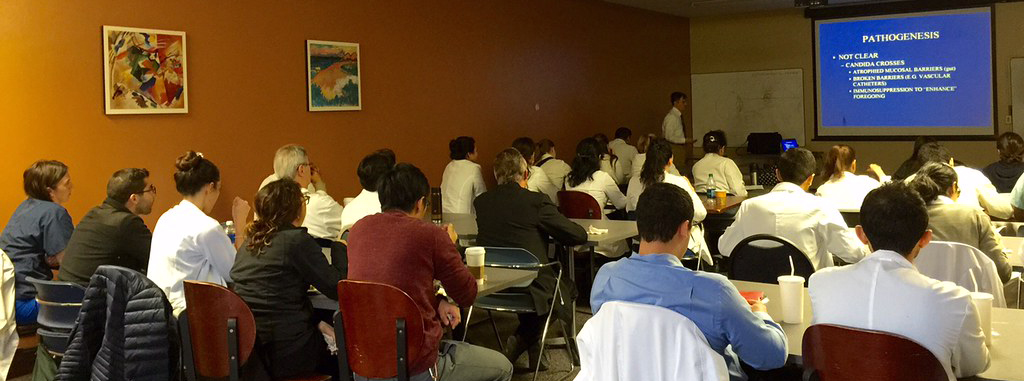The first U.S. hospital residency, numerous clinical externships, and two university health centers train Five Branches University students to be the best primary care doctors.
“In addition to the clinical training at the Five Branches University health centers, we provide offsite acupuncture and Chinese medicine treatments to patients at the Mental Health Client Action Network, to individuals with HIV/AIDS and Hepatitis C at the Santa Cruz AIDS Project, to elderly patients at the Akiyama Wellness Center, as well as onsite veterans and community clinics. These exceptional clinical externships have prepared us Highland Acupuncture Residents with the skills and training necessary to deal with conditions ranging from colds & flus, pain, chronic illness and degenerative diseases to stress, insomnia, mental health and reproductive health disorders.”
There is a new kind of medical training happening at Highland Hospital in Oakland, California. The first Acupuncture Residency program allows Five Branches University students the opportunity to train side-by-side with the best in Western biomedicine, while also providing medical residents, attendings, and faculty exposure to the dynamism of Acupuncture & East Asian Medicine.
It’s 7:55 am at Highland Hospital in Oakland, California. Originally built in 1927 as an academic teaching hospital, there is a new feeling in the air amidst the construction and recent dedication of the new Acute Care Tower here at Highland. I am sitting inside the Highland Care Pavilion’s third floor classroom, one of the more recent additions to this legendary hospital, waiting for the beginning of the morning report. As the medical students, residents, attendings, and teaching faculty pour into the classroom, my heart begins to beat slightly faster and my palms become a little sweaty. Everyone is here for the morning lesson as usual, except there are a few new faces in the crowd.
It’s not just the buildings that are new: my fellow Five Branches University colleagues and I are the first Acupuncture students and residents to be welcomed to this prestigious teaching hospital. I secretly wonder if we seem out of place, or if others will notice that our training and specialty is in Acupuncture and East Asian Medicine.

As the saying goes, “when in Rome, do as the Romans do,” so I act natural by drinking my morning coffee, preparing my iPad for note taking, and converse with my fellow acupuncture colleagues. Mostly we are commenting on our impressions of walking through the hallways of the hospital donning our white coats, the feeling of the academic environment and history, the warm and friendly smiles on everyone’s faces, and the palpable presence of excellence in education and patient care.
We are in the halls and classrooms of one of the most respected teaching hospitals in the United States. A hospital renowned for being the home of many firsts in medicine, and now, my fellow Five Branches colleagues and I are the very first Acupuncture residents to walk these halls. We are training within the Department of Medicine’s Division of Integrative Medicine, one of the first Integrative Medicine departments in the country, led by our Chief, Dr. Amy Matecki, MD, LAc.
It’s now 8:00 am and the lesson begins. The case study being presented is a 72 year old male patient admitted to the ER complaining of sudden nausea and vomiting. The medical resident presenting the case tells us that the patient is also experiencing dizziness and chest pain. The professor assisting the resident jumps in and asks the other residents for their immediate differentials based off of these symptoms and what they should rule out.
One student says, “We should rule out ACS (Acute Coronary Syndrome) and mesenteric ischemia.” “Great,” says the professor, “What would you ask next?” The student replies, “Have they ever experienced these symptoms before? Do they have a history of diabetes?” “Excellent,” says the professor, “Carry on with the vitals.”
The resident rattles off the patient’s presenting vitals and continues to explain the history of the patient’s present illness. What was initially diagnosed and triaged as a potential heart attack patient and sent to cardiology turns out to take a turn for the worse. A negative ECG and an unperformed full neurological exam have confirmed that this patient is not a typical presentation. The patient’s symptoms now included hoarseness, difficulty swallowing and a loss of the ability to sense changes in temperature. Now I understand why this case was presented as a teaching point.
“This case is a classic example of medical framing,” says the professor. “A patient presents with certain symptoms, in this case nausea and chest pain, and everyone thinks ACS. However, the patient was actually suffering from a stroke in his brain stem.” The patient suffered from lateral medullary syndrome, also known as Wallenburg’s syndrome, which affects the cerebellum and Cranial Nerve 8.
Unfortunately, this patient was not triaged properly within the correct amount of time to prevent permanent damage and debilitation. It is a stark and somber reminder of the importance in proper patient intake, a complete physical exam, differential diagnosis, and the willingness to always look for another cause of a patient’s symptoms. This is what it means to train in the hospital environment. This is the responsibility that is placed upon our shoulders as medical professionals. This was only the morning teaching point.
It’s 8:45 am and everyone begins to leave the classroom. It’s time to begin the inpatient rounds and start today’s education with fresh eyes and a further refined mind.
I am grateful for the clinical training I have received at Five Branches. It has prepared me to walk these halls confidently. As I pass the Outpatient Psychiatric Ward I am reminded of my externship training at the Mental Health Client Action Network (MHCAN) in Santa Cruz where I provided free acupuncture and East Asian Medicine to low-income and homeless individuals suffering from mental health disorders. Some of my fellow Five Branchers also provided medical services for individuals with HIV/AIDS and Hepatitis C patients with the Santa Cruz AIDS Project, also at MHCAN.
